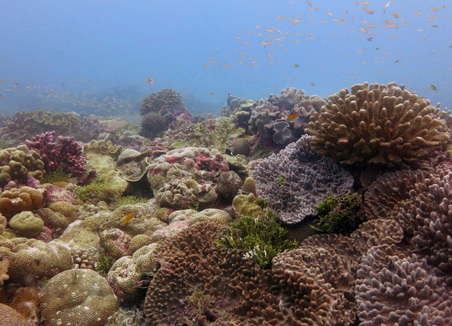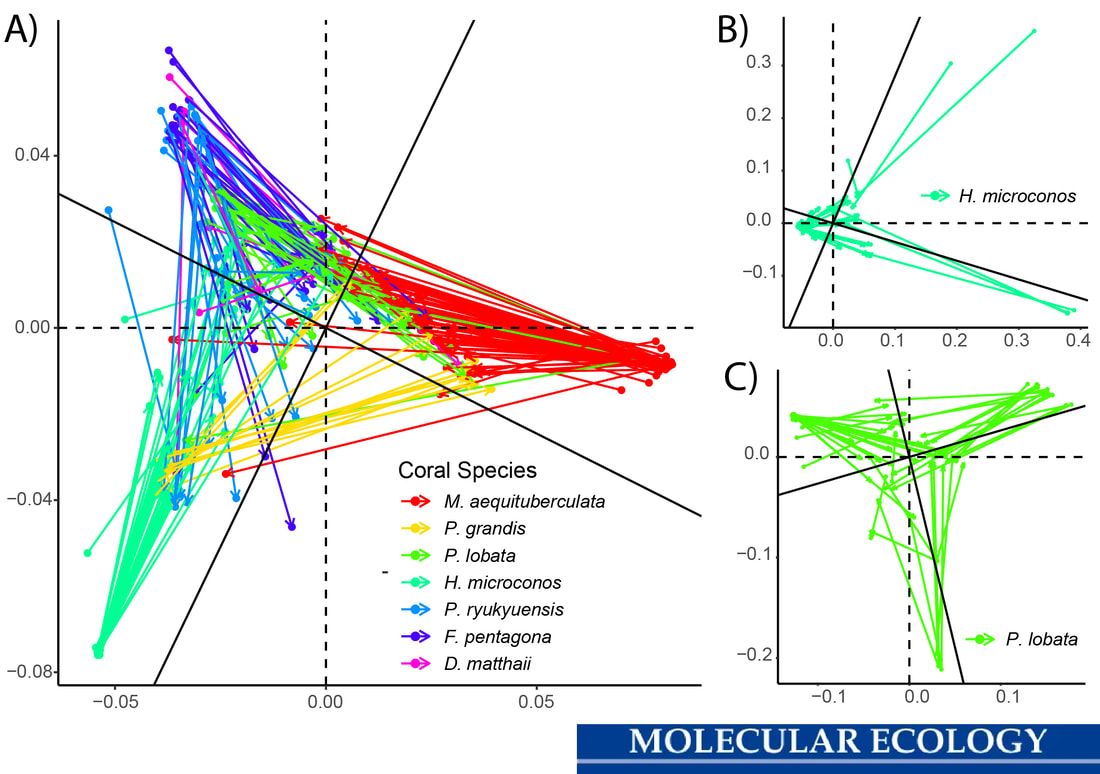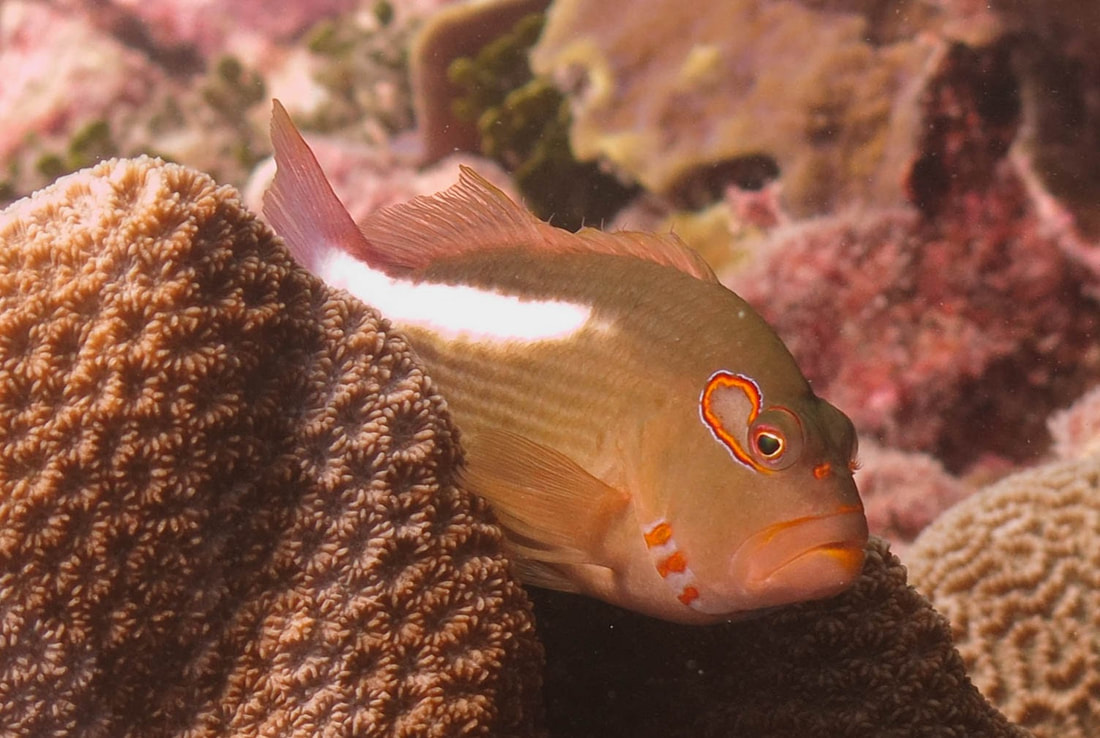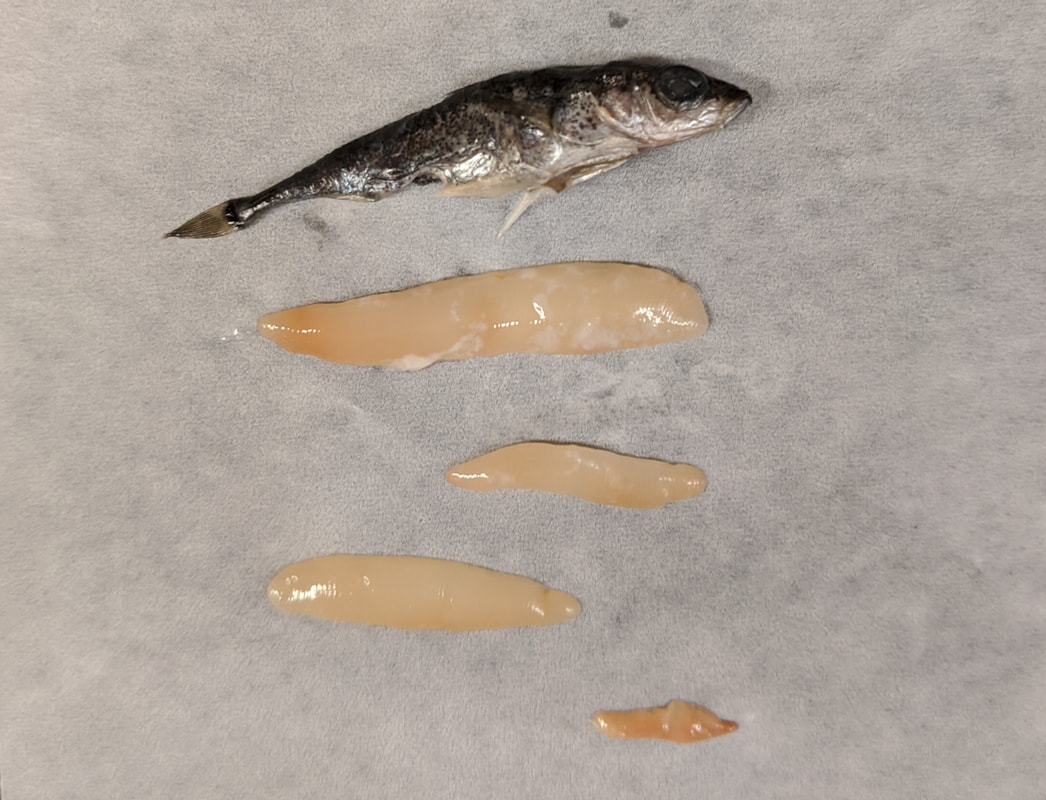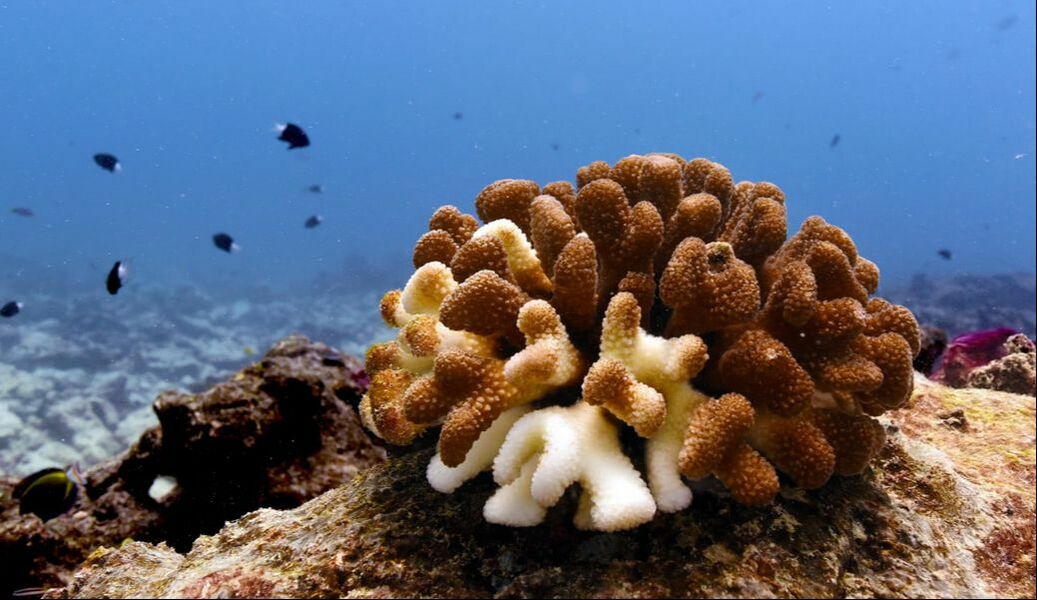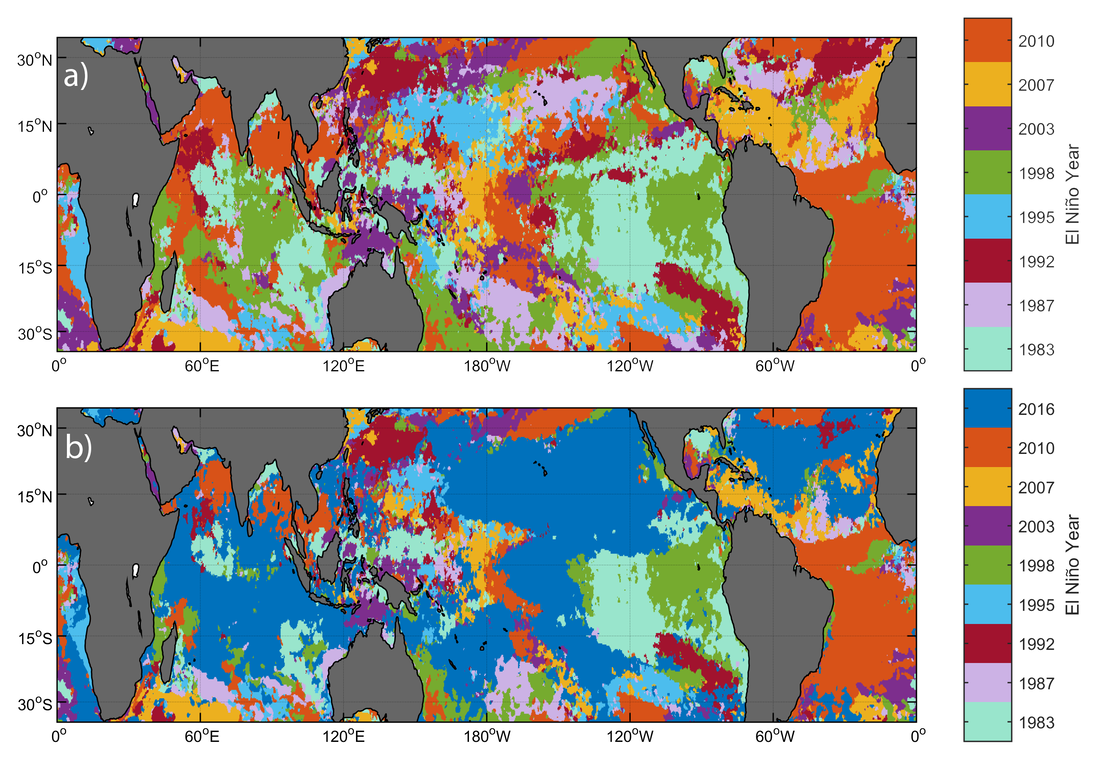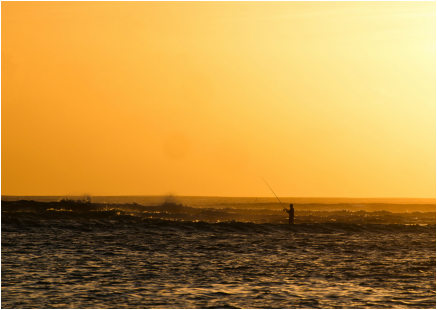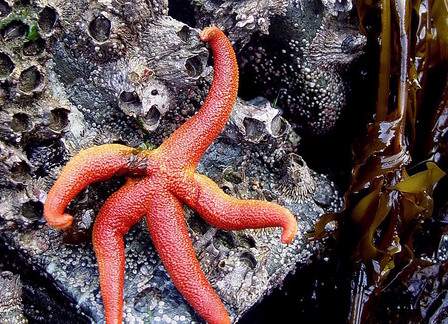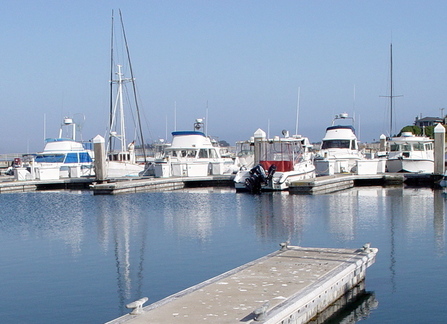Research Highlights:
|
How do synergistic impacts from local human disturbance and climate change affect the relationship between coral and their microbial symbionts?
Collaborators: Ruth Gates (in memoriam), Julia Baum, Jamie McDevitt-Irwin, Melissa Garren, Becky Vega-Thurber, Kieran Cox, Kristina Tietjen, Hannah Epstein, Ross Cunning, Andrew Baker, Sam Starko The relationship between coral and their microbial symbionts (including both symbiotic algae and bacteria) is important because it can provide insight into the history of coral bleaching, and indicate the overall health of coral. Our current focus is to evaluate the dynamics of coral symbioses in the context of environmental change. We use field surveys, next generation sequencing techniques, statistical models, and satellite-derived data to address these questions. Our goal is to better understand how the diversity and prevalence of coral symbionts vary over large-scale anthropogenic impact gradients, how symbioses change during pulse warming, and how these relationships tie into our current understanding of reef resilience. Related Manuscripts:
|
|
Is the abundance and diversity of fish parasites influenced by local or global stressors?
Parasites are ubiquitous in every environment where life is found, and yet little is known about how stress influences their community structure. Studying the parasites of tropical Pacific reef fish, we investigate macroecological patterns among these communities. This research sheds light on how stress influences fundamental ecological interactions, and how builds on my previous work studying how diversity changes under stress. Related Manuscript: |
|
How much energy does a parasite extract from its host?
This research merges historical data of parasite abundances with models based on the metabolic theory of ecology (MTE). We are currently exploring these concepts in three-spine stickleback from Alaskan lake ecosystems. By integrating old data with new analysis techniques, we can better understand the toll parasites take on their host, and how this might be altered in a changing climate. (Yes, all of those tapeworms came out of that one fish!!) |
Past Research
|
How did a major seawater warming event (2015-2016 El Niño) affect coral partnerships?
Collaborators: Ruth Gates (in memoriam), Julia Baum, Kristina Tietjen, Hannah Epstein, Ross Cunning, Andrew Baker I am currently studying how local and global impacts affect coral partnerships during the 2015-2016 major El Niño event. Corals partner with single-celled algae that live inside the coral tissue, which act like solar panels to power coral growth. When ocean temperatures warm up, these symbiotic partnerships can break down, causing coral bleaching and/or mortality. The 2015-2016 El Niño event allows us to understand how coral partnerships change when water temperatures increase over the course of a year. Stay tuned for this manuscript - coming soon! In a related opinion piece in Coral Reefs, Julia Baum and I argue that, for coral bleaching surveys, "Timing Matters". Specifically, we address changes in the length and intensity of recent coral bleaching events, and provide a conceptual framework and a specific example of how survey timing influences our perception of coral resilience. If survey timing is not considered during coral bleaching events, researchers may draw false conclusions and results regarding bleaching susceptibility, coral species-specific resistance, and resilience capacity. We provide recommendations for avoiding these potential pitfalls. |
|
What do we know about how El Niño affects coral reefs? A meta-analysis
Collaborators: Lisa Szostek, Jamie McDevitt-Irwin, Julian Schanze, Julia Baum Despite reports of extensive coral bleaching and up to 97% coral mortality during El Niño warming events, a quantitative synthesis of these events was lacking from the literature. To address this gap, we conducted a global meta-analysis of coral bleaching and mortality during El Niño. We are also in the process of developing an accessible coral heat stress product (interactive version under construction, v2 release anticipated in mid-2019). |
|
Subsistence in isolation: fishing dependence and perceptions of change on Kiritimati, the world's largest atoll Collaborators: Maryann Watson, Julia Baum This study, lead by Maryann Watson, sought to assess how people with very high reef dependence perceive and adapt to changes in their fisheries resources. See our Oceans and Coastal Management paper here, or check out our AudioSlides presentation here. |
|
How dynamic is coral health? Collaborators: Misaki Takabayashi, John Burns, Toni Makaniokekai Gregg For this project, we repetitively monitored coral colonies on the Big Island of Hawai'i in order to determine dynamics of reduced health states (such as coral bleaching, disease, algal overgrowth) at the colony scale. For a 3-D, interactive underwater virtual tour of our study site, see here. |
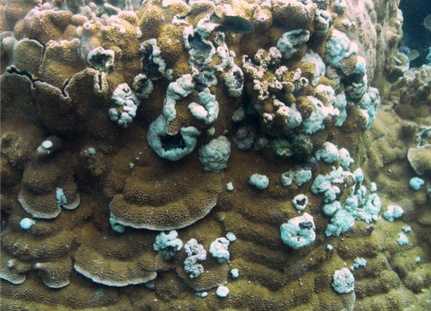
How do different coral maladies interact to determine
coral health?
Collaborator: Misaki Takabayashi
For my undergraduate thesis, I studied the effects of growth anomaly (GA) on susceptibility of the brown rice coral
(Montipora capitata) to algal overgrowth at Wai‘ōpae, Hawai‘i.
See our publication here.
|
How does temperature affect both the numbers and types of creatures that live along the shoreline? Collaborator: Kris Holdereid For this project, I studied the effect of temperature change on intertidal species assemblages in Kachemak Bay, Alaska with the NOAA/UAF Kasitsna Bay Laboratory. Using a long-term intertidal biological dataset and continuous buoy monitoring data, I found intriguing temperature-related patterns in sessile invertebrate community structure |
|
How do we determine the status of fish populations that we know little about? Collaborators: Jim Berkson, Elizabeth Hamman, Katelin Shugart-Schmidt, Molly Broome, Toby Matthews, Miguel Salazar I participated in the NMFS RTR Program and conducted a preliminary stock assessment of the tomtate (Haemulon aurolineatum). This report became part of a collaborative NOAA Technical Memo assessing 4 data-poor stocks in the U.S. South Atlantic. |
|
Life on the Docks: How do sea squirts affect real estate and growth of their underwater neighbours? Collaborators: Jay Stachowicz, Kyle Edwards Fouling communities, the groups of organisms that grow on docks and other human-built structures, are composed of sea squirts (tunicates), bryozoans (moss animals), and many other invertebrates. These communities provide an ideal model system to understand ecological interaction mechanisms. For this project I studied tradeoffs of mutualism and competition in sessile fouling community invertebrates with the UC Davis Bodega Marine Laboratory, see our publication here. |
